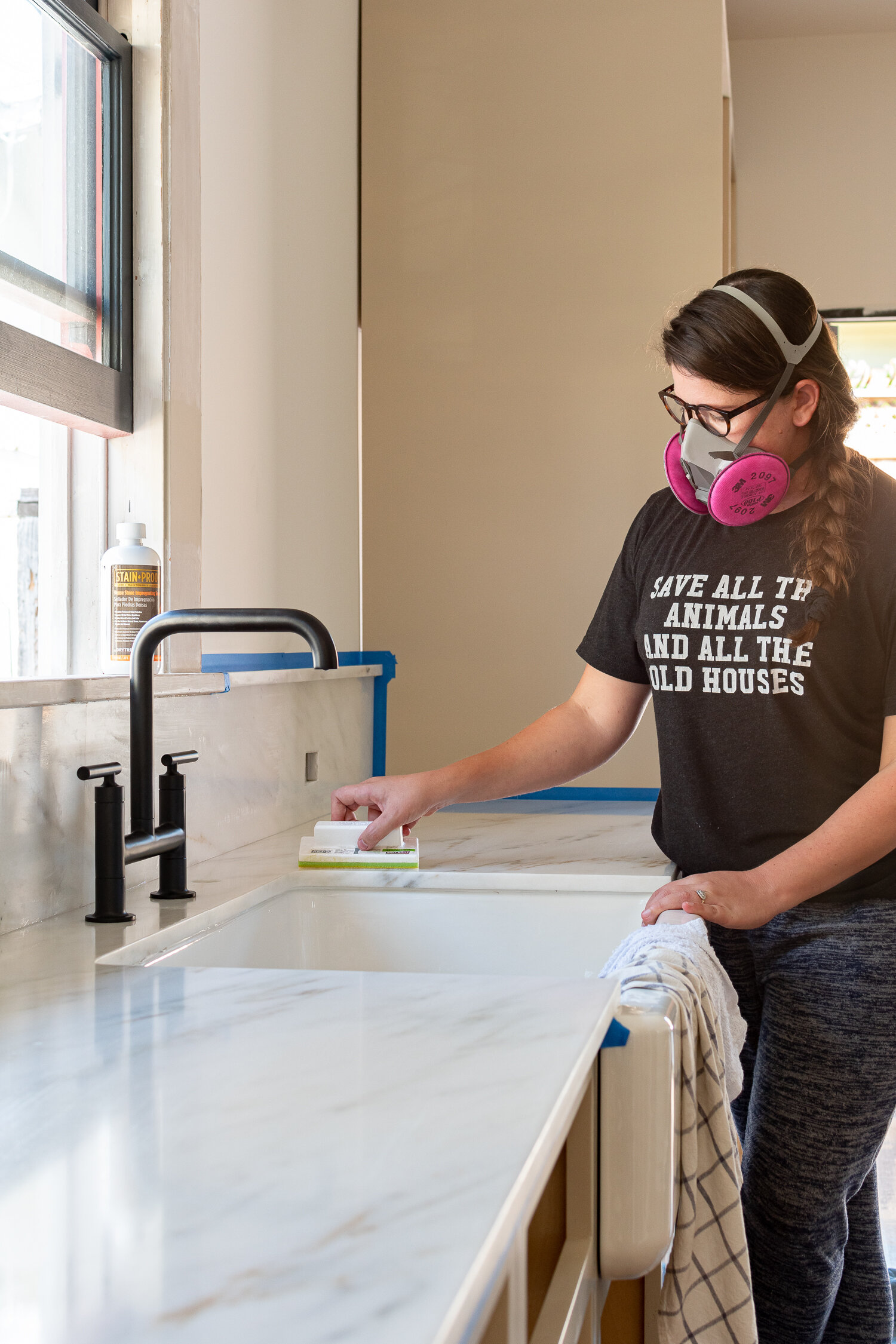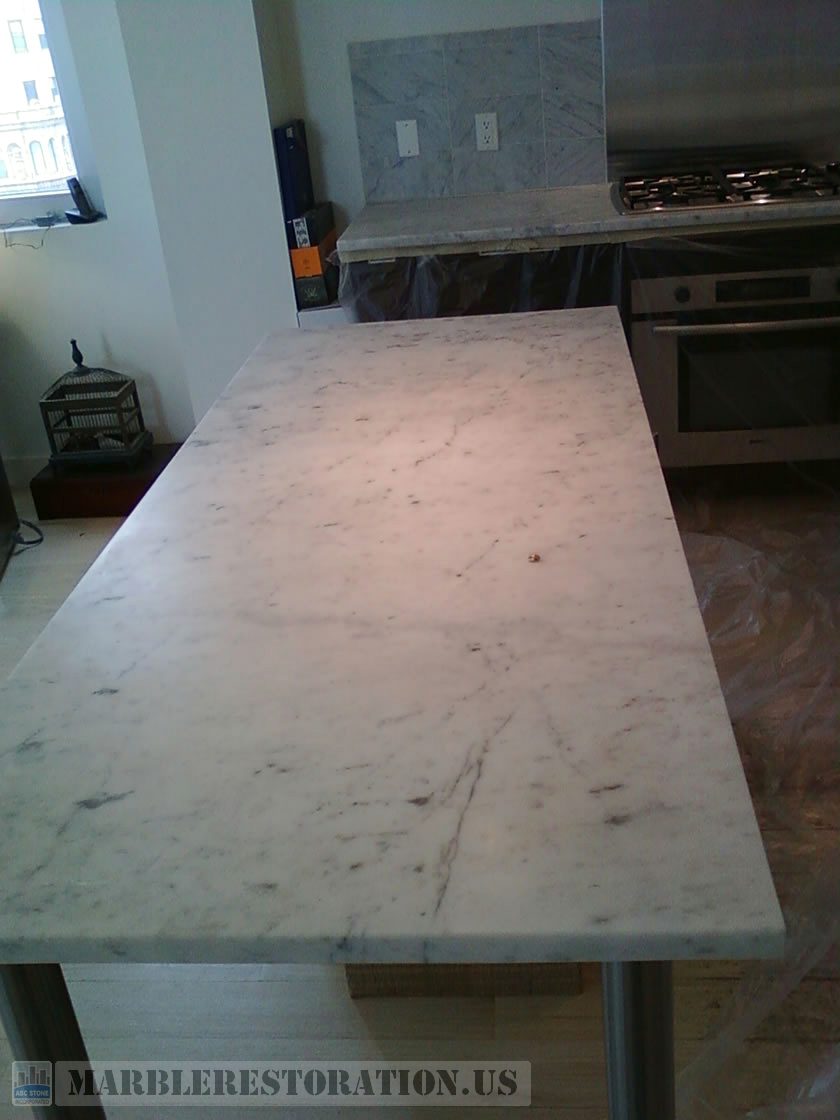The Art of Refurbishing Marble Countertops
Marble countertops are renowned for their timeless elegance and natural beauty, making them a popular choice for kitchen renovations. However, over time, marble countertops can become worn, scratched, or dulled due to everyday use and exposure to various elements. Refurbishing marble countertops is a cost-effective way to breathe new life into your kitchen space, restoring the luster and luxury of the surface. In this comprehensive guide, we’ll discuss the refurbishing process, benefits, considerations, and tips for revitalizing marble countertops.

Understanding the Refurbishing Process
Refurbishing marble countertops involves several steps to repair damage, remove stains, and restore the surface to its original beauty. The process typically includes the following:
Cleaning: Begin by thoroughly cleaning the marble countertop surface to remove any dirt, grease, or residue. Use a mild detergent or stone cleaner and warm water, followed by a soft cloth or sponge to gently scrub the surface. Avoid acidic or abrasive cleaners that can damage the marble.
Repairing Damage: Assess the countertop for any chips, cracks, or scratches that need repair. Minor imperfections can often be filled with epoxy or resin and polished to blend seamlessly with the surrounding marble. For larger or more significant damage, consult with a professional stone restoration specialist.
Stain Removal: Treat any stubborn stains or discoloration on the marble surface using a poultice or commercial stain remover specifically designed for marble. Apply the poultice to the stained area, cover it with plastic wrap, and allow it to sit overnight to draw out the stain. Rinse the poultice off with water and gently scrub the area with a soft brush or sponge.
Polishing and Sealing: Once the marble countertop is clean and repaired, polish the surface to restore its shine and smoothness. Use a marble polishing compound or buffing pads to achieve a high-gloss finish. Finally, apply a marble sealant to protect the surface from future stains, etching, and moisture damage.

Benefits of Refurbishing Marble Countertops
Refurbishing marble countertops offers several benefits, both aesthetic and functional, including:
Restored Beauty: Refurbishing marble countertops revitalizes the surface, removing scratches, stains, and dullness to reveal the natural beauty and veining of the stone. The polished finish enhances the elegance and sophistication of the kitchen space.
Enhanced Durability: Properly maintained and sealed marble countertops are more resistant to scratches, stains, and etching, prolonging their lifespan and preserving their integrity. Refurbishing reinforces the structural stability of the surface, ensuring long-lasting performance.
Cost-effectiveness: Refurbishing marble countertops is a cost-effective alternative to replacing the entire surface. By addressing issues such as scratches, stains, and dullness, homeowners can avoid the expense and inconvenience of a full countertop replacement.
Increased Property Value: Well-maintained marble countertops enhance the overall value and appeal of the home, making it more attractive to potential buyers. Refurbishing the countertops before putting the house on the market can yield a higher return on investment.

Considerations Before Refurbishing
Before embarking on the refurbishing process, homeowners should consider the following factors:
Type of Damage: Assess the extent and type of damage to the marble countertops to determine if refurbishing is the best course of action. Minor scratches, stains, and dullness are typically suitable for refurbishing, while extensive damage may require professional restoration or replacement.
DIY vs. Professional Services: While some minor repairs and refurbishing tasks can be done DIY, more significant damage or specialized treatments may require professional services. Consider your skill level, time availability, and budget before deciding whether to tackle the project yourself or hire a professional.
Sealing and Maintenance: After refurbishing the marble countertops, it’s essential to seal the surface with a high-quality marble sealant to protect it from future damage and staining. Establish a regular maintenance routine, including cleaning and sealing, to preserve the beauty and integrity of the countertops.
Budget and Timeline: Determine your budget and timeline for the refurbishing project, taking into account the cost of materials, tools, and potential professional services. Plan accordingly to ensure a smooth and efficient refurbishing process without exceeding your budget or timeline constraints.

Common Mistakes to Avoid
Using Harsh Cleaners: Avoid using acidic or abrasive cleaners on marble countertops, as they can etch or dull the surface over time. Stick to mild detergents or stone cleaners specifically formulated for marble to prevent damage.
Neglecting Sealing: Failure to seal marble countertops regularly leaves them vulnerable to stains, etching, and moisture damage. Apply a marble sealant every 6 to 12 months, or as recommended by the manufacturer, to protect the surface and maintain its integrity.
Overlooking Professional Help: While DIY refurbishing can save money, it’s essential to recognize when professional help is needed for more extensive damage or specialized treatments. Attempting complex repairs without the necessary expertise can lead to further damage or costly mistakes.
Skipping Surface Preparation: Proper cleaning and surface preparation are crucial for achieving optimal results when refurbishing marble countertops. Neglecting to clean the surface thoroughly or repair minor damage before polishing and sealing can result in unsatisfactory outcomes.

How often should marble countertops be refurbished?
The frequency of refurbishing marble countertops depends on factors such as usage, maintenance, and the quality of the original installation. In general, marble countertops may benefit from refurbishing every 5 to 10 years to address wear and tear and maintain their appearance.
Can scratches on marble countertops be repaired?
Minor scratches on marble countertops can often be buffed out or filled with a marble polishing compound to restore the surface to its original smoothness. For deeper scratches or gouges, professional stone restoration services may be required.
Will refurbishing marble countertops change their color or veining?
Refurbishing marble countertops should not significantly alter their color or veining, as the process primarily focuses on repairing surface damage and restoring the natural shine of the stone. However, polishing and sealing may enhance the color and veining, bringing out the stone’s inherent beauty.
Are marble countertops prone to staining after refurbishing?
Properly sealed and maintained marble countertops are less susceptible to staining after refurbishing. Applying a high-quality marble sealant helps protect the surface from spills, moisture, and acidic substances that can cause staining or etching.
Can I use DIY products to refurbish marble countertops, or should I hire a professional?
DIY products and techniques can be used for minor repairs and refurbishing tasks on marble countertops, such as polishing and sealing. However, for more extensive damage or specialized treatments, it’s advisable to hire a professional stone restoration specialist who has the expertise and equipment to achieve optimal results.

Cultured Marble Resurfacing Marble countertops bathroom, Marble

How to Polish Marble Countertops CounterTop Guides

Marble Countertops Restoration (Place Order Here)

How to Polish a Damaged Marble Countertop : 6 Steps – Instructables

Related articles:
- DIY Refinishing Cultured Marble Countertops
- Marble Countertops In Bathrooms
- Cultured Marble Countertops
- Gray Kitchen Cabinets Marble Countertops
- Modern Kitchen Marble Countertops
- Refinish Cultured Marble Countertop
- Carrara Marble Countertops Bathroom
- Marble Countertops Types
- How To Refinish Marble Countertops
- White Gray Marble Countertops